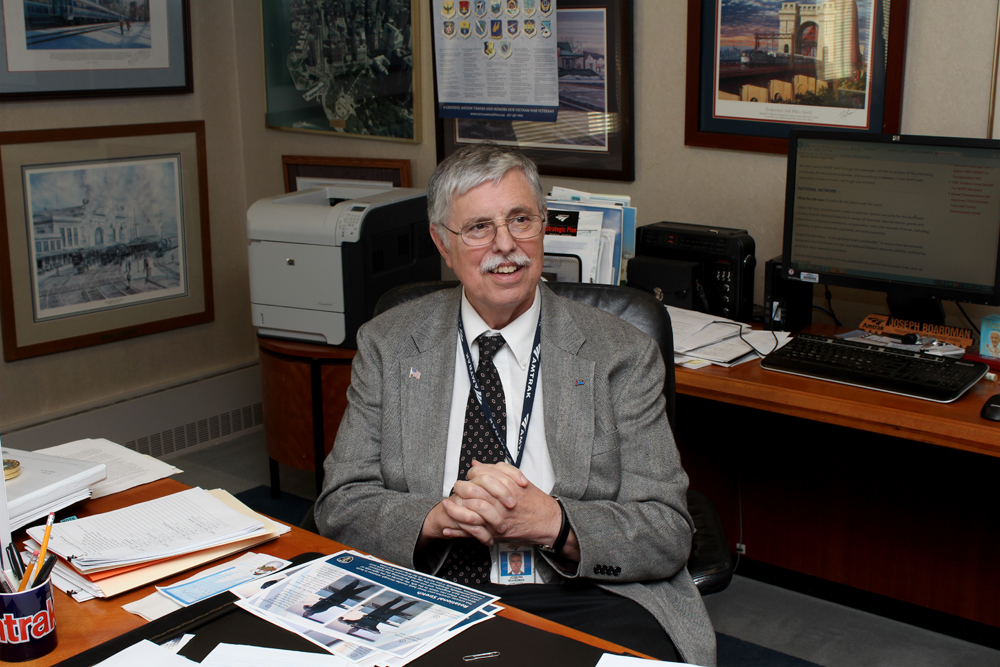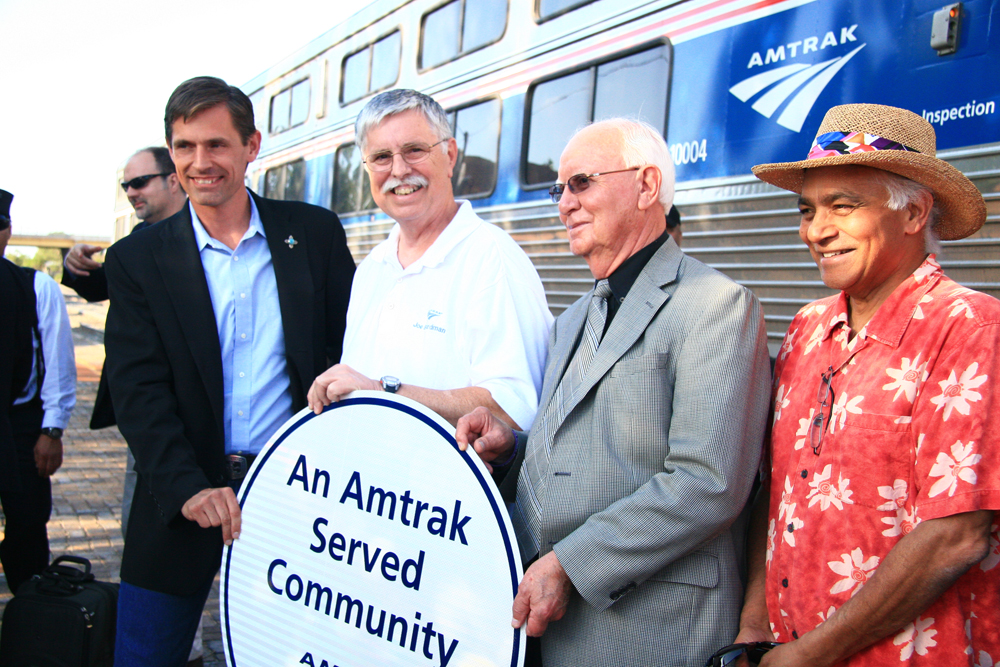Since retiring as Amtrak’s president and CEO in 2016 after eight years on the job, Joe Boardman has actively monitored developments at the company as Wick Moorman and Richard Anderson successively assumed his former role in each of the following years. He has been open in expressing opinions about apparent changes in the company’s priorities since he left Washington for his home in Rome, N.Y. Trains spoke with Boardman to further explore his concerns and put perspective on his tenure.
Q. What changes do you believe managers have made to Amtrak safety initiatives?
A. We had a program that trained employees with extensive railroad knowledge — engineers and in some cases conductors and road foremen — as behavioral-based safety people and coordinators that could help us with risk assessment, but Moorman killed it. And the budget was wiped out for the Zero Defect Safety program at [New York] Penn Station under Wick’s watch.
So that’s why the [March and April 2017] Penn Station derailments occurred. Wick wasn’t paying attention; he was only there a day or two per week.
Decisions were made without reviewing the impact to safety, revenue generation, and customer service of allowing 400 non-union management people to leave the company in buyouts. After the accidents in Washington state [Amtrak Cascades No. 501 in December 2017] and the southbound Silver Star in South Carolina two months later, senior leadership began to talk about Amtrak as being unsafe without positive train control. My argument is that Richard Anderson’s comments were damaging to the company when there was no reason or necessity for that damage other than to cover your tracks.
I don’t dispute the fact that operational positive train control would have protected those trains, but we’ve been running a safe railroad long before PTC. The closest thing would be automatic train stop — ATS — on the Southwest Chief route and that’s one they don’t want to run at all.
A. They talk about freight delays on the national network. Probably the most reliable service we could run is from Kansas City, Mo., to Albuquerque, N.M., about 950 miles where we are the only trains operating. That was my vision: No freight interference. Because the line has ATS, at some point we can increase that to 90 mph across Kansas and have even faster, more reliable service.
I really fault Amtrak management in pushing for positive train control on the exempted service right now. [There is no] way it should cost $8 million a year to maintain a signal system. For Amtrak management to renege now [by not providing a $3-million match to leverage a $25-million federal infrastructure improvement grant] about what really could happen to improve that line is beyond me. …
The Federal Railroad Administration has to be completely responsible for oversight of safety.
For Amtrak to come in and say that it had decided to do something safer on an exempt-from-PTC-route such as the Southwest Chief’s — and then say it’s too expensive so we won’t run it — doesn’t balance the risk with the need to provide the service. The Amtrak board’s job is to carry out the national rail system policy of Congress, but instead they pass a mealy-mouthed policy saying they will only run on tracks that have that. And yet, they’ve asked for [PTC implementation] extensions.
A. One of the things you find out when you get to Amtrak is that you just don’t put butts in seats to maximize revenue. If you listen to the customers, they are willing to pay a greater amount for better service. We talked a lot about things we’d like to do with the dining cars, but if you’ll remember, we had this Congressman [former U.S. Rep. John Mica, R-Fla.] who constantly complained that you couldn’t sell food unless you were making a profit with it.
We also viewed private cars and charters as a revenue opportunity. Once the short platform problem at the Miami station was mitigated and we were able to run trains in there, we put head-end power on some of the tracks at the existing station so we could generate revenue there. But now they don’t want charters or the private-car business. Here’s the problem: if you don’t follow through on what previous CEOs have done, then you lose your credibility as an organization.
A. Cost has become a driver in a way that it has begun to damage the system. We had an overall revenue goal. But individual management goals that influence monetary bonuses were based on cost targets, not revenue. The incentive program needs to be revamped so cutting expenses is not the sole focus. I mean, eventually what are you going to cut if it is not the sole focus? Everything? And not run the trains? The intent of Congress was to do as good a job as we could, but now it’s just plain cost cutting: Throwing employees out of the stations and reservation centers, cutting meal service. …
This is what is amazing to me: The board felt they became more knowledgeable only because they had better financial information. I insisted on transparency. [You’re] going to have the confidence of Congress if [you] are telling them exactly what the numbers are. And that’s exactly what they’re not doing — on purpose — now, because they think they are smarter than everyone else. [Amtrak Chairman Anthony Coscia wants numbers lumped together] because they seem to agree with the blockheaded moves management is making right now. I don’t think Richard Anderson ever did an honest assessment of what [the board was] up to and where they were going.
A. Amtrak wasn’t created to run the Northeast Corridor, it was created to operate the national network, which they are trying to get out of running on a regular basis. The NEC’s infrastructure needs to be owned and built by the U.S. government, and they can defer to the states using the Interstate Highway System model for the most efficient operation of Amtrak, NJ Transit, Metro-North, and the Long Island [Rail Road] — all publicly owned railroads in their own right.
I think a federal administration with an administrator should be responsible for Amtrak and run passenger rail in the U.S.; the person should have a five-to-10-year appointment. For that to happen, there needs to be a real passenger-rail-transportation policy — not policies that are half-hearted deflections to the Federal Transit Administration or the Federal Railroad Administration.
The administrator should run it with a fairly small staff able to tap knowledge of real railroaders and demand transparency and accountability from management. We need a CEO who recognizes what needs to be done on behalf of a national system and a board that needs to get the hell out of the way. If the board is only interested in the Northeast Corridor or [real estate] development, then they are missing their primary obligation of running a railroad.
A lot of those [Amtrak’s directors] are honestly good people but they are not knowledgeable enough about policies that they should be about long-distance trains. My view is that the investment we are making in the national network provides a backbone for the nation in the future, and is the core of Amtrak.
















For the Record: that accident in South Carolina occurred BECAUSE of PTC. The existing signal system was turned off because of work to install PTC; if there had been no PTC work two people might be alive today. I know there are errors in GPS–I live yards away from one. Check your GPS, call up exit 32 on I-93 in Mass.: does it show Washington Ave. as coming into the Rte. 60 rotary? Well it doesn’t; there’s a curb and a fence and a tree in the way! When I moved in in 2007 maybe once a month I saw the police backing some poor trucker under guard on Washington Ave. to a point where he could turn in a narrow street. I fear PTC is going to be a huge waste, even tho’ BNSF/Warren Buffett says it’s already prevented one collision. Mr. Buffett, this says your railroad has got some problems to join your food/beverage woes…
Boardman sounds just like former president Gunn, both pointed to a board of directors whose purpose was to dismantle, destroy, and eliminate interstate train travel.
Since we the people own Amtrak, it’s time we claim control and use our power to vote directly on who sits on the board of directors.
Congress can’t do it, since they only appoint those who supported their reelection campaigns.
TRAINS recent article on Amtrak accounting principles just further illustrates why we must wrestle Amtrak from government control.
The government always messes up anything they try to regulate.
Interesting photo of Mr. Boardman in his office. No plush digs there! How many CEO’s have a counter with a computer and printer directly behind them instead of a glass wall looking out on some cityscape? Maybe Amtrak was overhead heavy, but it doesn’t show in that picture.
As a 15-year Amtrak veteran, I concur with Joe Boardman’s assessment. The NEC has been an anchor around Amtrak’s fiscal neck, since the shotgun wedding of Penn Central and Amtrak, on May 1, 1971. My math may be a little off, but it appears as if 95% of Amtrak’s annual stipend, is going to maintain just around 800 miles of railroad. There needs to be a more reasonable division of operating resources.